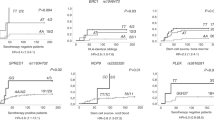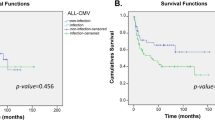Abstract
Graft-versus-host disease (GVHD) is a frequent complication after hematopoietic cell transplant (HCT). Tissue damage as a result of chemoradiation injury is the initiating event in the pathogenesis of acute GVHD. Variations in DNA repair can influence the amount of tissue damage in response to alkylating agents and ionizing radiation used as conditioning during HCT. As DNA damage caused by these agents is repaired by the base excision repair (BER) pathway, we hypothesized that single-nucleotide polymorphisms (SNPs) in BER pathway will be associated with GVHD after HCT. Hence, we analyzed 179 SNPs in BER pathway in 470 recipients of allogeneic HCT for association with acute and chronic GVHD. In multivariate analysis, one SNP (rs6844176) in RFC1 (replication factor C (activator 1)) gene was independently associated with a higher risk of grade II–IV acute GVHD (relative risk (RR): 1.39, 95% confidence interval (CI): 1.14–1.70, P=0.001), and showed a trend toward higher risk of grade III–IV acute GVHD (RR: 1.33, 95% CI: 0.95–1.85, P=0.09). One SNP in PARP1 gene (rs1805410) was associated with a higher risk of chronic GVHD (RR: 1.81, 95% CI: 1.29–2.54, P=0.001). These results show that SNPs in the BER pathway can be used as genetic biomarkers to predict those at high risk for GVHD toward whom novel prophylactic strategies could be targeted.
This is a preview of subscription content, access via your institution
Access options
Subscribe to this journal
Receive 12 print issues and online access
$259.00 per year
only $21.58 per issue
Buy this article
- Purchase on Springer Link
- Instant access to full article PDF
Prices may be subject to local taxes which are calculated during checkout



Similar content being viewed by others
References
Socie G, Blazar BR . Acute graft-versus-host disease; from the bench to the bedside. Blood 2009; 114: 4327–4336.
Martin PJ . Biology of chronic graft-versus-host disease: implications for a future therapeutic approach. Keio J Med 2008; 57: 177–183.
Lieberman HB . DNA damage repair and response proteins as targets for cancer therapy. Curr Med Chem 2008; 15: 360–367.
Thyagarajan B, Lindgren B, Basu S, Nagaraj S, Gross M, Weisdorf D et al. Association between genetic variants in the base excision repair pathway and outcomes after hematopoietic cell transplant. Biol Blood Marrow Transplant 2010, (e-pub ahead of print).
Weisdorf D, Spellman S, Haagenson M, Horowitz M, Lee S, Anasetti C et al. Classification of HLA-matching for retrospective analysis of unrelated donor transplantation: revised definitions to predict survival. Biol Blood Marrow Transplant 2008; 14: 748–758.
NIEHSSNPs. NIEHS Environmental Genome Project, University of Washington, Seattle, WA (URL: http://www.egp.gs.washington.edu); January 2008.
Ramensky V, Bork P, Sunyaev S . Human non-synonymous SNPs: server and survey. Nucleic Acids Res 2002; 30: 3894–3900.
Ng PC, Henikoff S . Accounting for human polymorphisms predicted to affect protein function. Genome Res 2002; 12: 436–446.
Yue P, Melamud E, Moult J . SNPs3D: candidate gene and SNP selection for association studies. BMC Bioinformatics 2006; 7: 166.
RD Core Team. R: A Language and Environment for Statistical Computing. Foundation for Statistical Computing: Vienna, Austria, 2008.
Barrett JC, Fry B, Maller J, Daly MJ . Haploview: analysis and visualization of LD and haplotype maps. Bioinformatics 2005; 21: 263–265.
Fine J, Gray R . A proportional hazards model for the sub distribution of a competing risk. J Am Stat Assoc 1999; 94: 496–509.
Jagtap P, Szabo C . Poly (ADP-ribose) polymerase and the therapeutic effects of its inhibitors. Nat Rev Drug Dis 2005; 4: 421–440.
Zong WX, Ditsworth D, Bauer DE, Wang ZQ, Thompson CB . Alkylating DNA damage stimulates a regulated form of necrotic cell death. Genes Dev 2004; 18: 1272–1282.
Edinger AL, Thompson CB . Death by design: apoptosis, necrosis and autophagy. Curr Opin Cell Biol 2004; 16: 663–669.
Berger NA, Berger SJ . Metabolic consequences of DNA damage: the role of poly (ADP-ribose) polymerase as mediator of the suicide response. Basic Life Sci 1986; 38: 357–363.
Ha HC, Snyder SH . Poly(ADP-ribose) polymerase is a mediator of necrotic cell death by ATP depletion. Proc Natl Acad Sci USA 1999; 96: 13978–13982.
Virag L, Szabo C . The therapeutic potential of poly(ADP-ribose) polymerase inhibitors. Pharmacol Rev 2002; 54: 375–429.
Chiarugi A . Poly(ADP-ribose) polymerase: killer or conspirator? The ‘suicide hypothesis’ revisited. Trends Pharmacol Sci 2002; 23: 122–129.
Hassa PO, Hottiger MO . A role of poly (ADP-ribose) polymerase in NF-κB transcriptional activation. Biol Chem 1999; 380: 953–959.
McCarroll SA, Bradner JE, Turpeinen H, Volin L, Martin PJ, Chilewski SD et al. Donor-recipient mismatch for common gene deletion polymorphisms in graft-versus-host disease. Nat Genet 2009; 41: 1341–1344.
Bleakley MR, Riddell SR . Molecules and mechanisms of the graft-versus-leukaemia effect. Nat Rev Cancer 2004; 4: 371–380.
Goulmy E, Schipper R, Pool J, Blockland E, Falkenburg JH, Vossen J et al. Mismatches of minor histocompatibility antigens between HLA-identical donors and recipients and the development of graft-versus-host disease after bone marrow transplantation. N Engl J Med 1996; 334: 281–285.
Tseng LH, Lin MT, Hansen JA, Gooley T, Pei J, Smith AG et al. Correlation between disparity for the minor histocompatibility antigen HA-1 and the development of acute graft-versus-host disease after allogeneic marrow transplantation. Blood 1999; 94: 2911–2914.
Gallardo D, Arostegui JI, Balas A, Torres A, Caballero D, Carreras E et al. Disparity for the minor histocompatibility antigen HA-1 is associated with an increased risk of acute graft-versus-host disease (GvHD) but it does not affect chronic GvHD incidence, disease-free survival or overall survival after allogeneic human leucocyte antigenidentical sibling donor transplantation. Br J Haematol 2001; 114: 931–936.
Socie G, Loiseau P, Tamouza R, Janin A, Busson N, Gluckman E et al. Both genetic and clinical factors predict the development of graft-versus-host disease after allogeneic hematopoietic stem cell transplantation. Transplantation 2001; 72: 699–706.
Nesci S, Buffi O, Iliescu A, Andreani M, Lucarelli G . Recipient mHag-HA1 disparity and aGVHD in thalassemic-transplanted patients. Bone Marrow Transplant 2003; 31: 575–578.
Tait BD, Maddison R, McCluskey J, Deayton S, Heatley S, Lester S et al. Clinical relevance of the minor histocompatibility antigen HA-1 in allogeneic bone marrow transplantation between HLA identical siblings. Transplant Proc 2001; 33: 1760–1761.
Miklos DB, Kim HT, Zorn E, Hochberg EP, Guo L, Mattes-Ritz A et al. Antibody response to DBY minor histocompatibility antigen is induced after allogeneic stem cell transplantation and in healthy female donors. Blood 2004; 103: 353–359.
Zorn E, Miklos DB, Floyd BH, Mattes-Ritz A, Guo L, Soiffer RJ et al. Minor histocompatibility antigen DBY elicits a coordinated B and T cell response after allogeneic stem cell transplantation. J Exp Med 2004; 199: 1133–1142.
Nishida T, Akatsuka Y, Morishima Y, Hamajima N, Tsujimura K, Kuzushima K et al. Clinical relevance of a newly identified HLA-A24-restricted minor histocompatibility antigen epitope derived from BCL2A1, ACC-1, in patients receiving HLA genotypically matched unrelated bone marrow transplant. Br J Haematol 2004; 124: 629–635.
Marijt WA, Heemskerk MH, Kloosterboer FM, Goulmy E, Kester MG, van der Hoorn MA et al. Hematopoiesis-restricted minor histocompatibility antigens HA-1- or HA-2-specific T cells can induce complete remissions of relapsed leukemia. Proc Natl Acad Sci USA 2003; 100: 2742–2747.
Antin JH, Ferrara JL . Cytokine dysregulation and acute graft-versus-host disease. Blood 1992; 80: 2964–2968.
Cavet J, Middleton PG, Segall M, Noreen H, Davies SM, Dickinson AM . Recipient tumor necrosis factor-alpha and interleukin-10 gene polymorphisms associate with early mortality and acute graft-versus-host disease severity in HLA-matched sibling bone marrow transplants. Blood 1999; 94: 3941–32946.
Lin MT, Storer B, Martin PJ, Tseng LH, Gooley T, Chen PJ et al. Relation of an interleukin-10 promoter polymorphism to graft-versus-host disease and survival after hematopoietic-cell transplantation. N Engl J Med 2003; 349: 2201–2210.
Dickinson AM, Charron D . Non-HLA immunogenetics in hematopoietic stem cell transplantation. Curr Opin Immunol 2005; 17: 517–525.
Holler E, Rogler G, Brenmoehl J, Hahn J, Herfarth H, Greinix H et al. Prognostic significance of NOD2/CARD15 variants in HLA-identical sibling hematopoietic stem cell transplantation: effect on long-term outcome is confirmed in 2 independent cohorts and may be modulated by the type of gastrointestinal decontamination. Blood 2006; 107: 4189–4193.
Acknowledgements
This work was supported by NIAID (R21 AI079354-01) and the Leukemia Research Fund, University of Minnesota.
Author information
Authors and Affiliations
Corresponding author
Ethics declarations
Competing interests
Dr Mukta Arora has received funding from the Leukemia Research Fund, University of Minnesota; and from NIAID for this project. Dr Bharat Thyagarajan has received funding from NIAID; the other co-authors declare no conflict of interest.
Rights and permissions
About this article
Cite this article
Arora, M., Lindgren, B., Basu, S. et al. Polymorphisms in the base excision repair pathway and graft-versus-host disease. Leukemia 24, 1470–1475 (2010). https://doi.org/10.1038/leu.2010.139
Received:
Revised:
Accepted:
Published:
Issue Date:
DOI: https://doi.org/10.1038/leu.2010.139
Keywords
This article is cited by
-
Association study of candidate DNA-repair gene variants and acute graft versus host disease in pediatric patients receiving allogeneic hematopoietic stem-cell transplantation
The Pharmacogenomics Journal (2022)
-
Risk model incorporating donor IL6 and IFNG genotype and gastrointestinal GVHD can discriminate patients at high risk of steroid refractory acute GVHD
Bone Marrow Transplantation (2015)
-
Biologic markers of chronic GVHD
Bone Marrow Transplantation (2014)
-
The role of non-HLA gene polymorphisms in graft-versus-host disease
International Journal of Hematology (2013)



